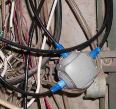Electrical installation and switching of wires on terminal blocks
 Types of wiring terminal blocks
Types of wiring terminal blocks
Modern terminal blocks for wiring made of translucent or colored plastic, inside which they themselves are placed terminals with threaded sockets.
You can switch terminal wires in two ways:
- each wire for its own screw;
- each wire through the entire terminal for both screws.
The second method gives a more reliable contact, both in the sense of mechanical fastening, and in the sense of a larger contact area and thus reducing the probability of heating. After installation, it is imperative to ensure that each end of the wire is securely fastened and no sockets can be removed.
How is the installation of wires in terminal blocks
Fixing wires in distribution boxes and junction boxes is a very responsible matter, because here a bad contact is not as noticeable as in a contact or a switch, which is always in our area of attention, and problems can appear too late.
On sale there are pads designed for different section wires. In a socket that is too wide, the screw will go through the wire, not tighten it. On the other hand, sometimes three wires (suitable, outgoing and jumper to the adjacent socket) need to be connected to one socket. Too small a hole diameter will not allow switching.
You can buy a distribution box with a built-in connector, however, it is quite inconvenient to install wires in it, especially when the cross section of the veins is more than 1.5 mm. It is easier to proceed as when installing plug sockets: pass the ends of the wires through the mounting holes of the box, connect them to the terminals, then immerse the block in the box and install Cover.
It should be borne in mind that there may always be an urgent need to open the box for branches, therefore furniture, paintings, etc. should not impede access to it. After installing separate lines in each room, it remains to lay the common lines of each group of junction boxes to the distribution board. We have already said that electrical wiring can be compared to a tree: the closer to the trunk, the thicker the branches. The thickness of the cable (or, more precisely, the cross-section of its core) becomes larger, the more groups are merged into it.
For example, if the lamps in the house are consumed in different rooms 1.0; 1.0; 1.5 and 0.5 kW, then the common line to which these branch, consumes the sum of these powers, that is, 4 kW. They must have the appropriate cross section of the wires and the appropriate rating (automatic) fuse.
